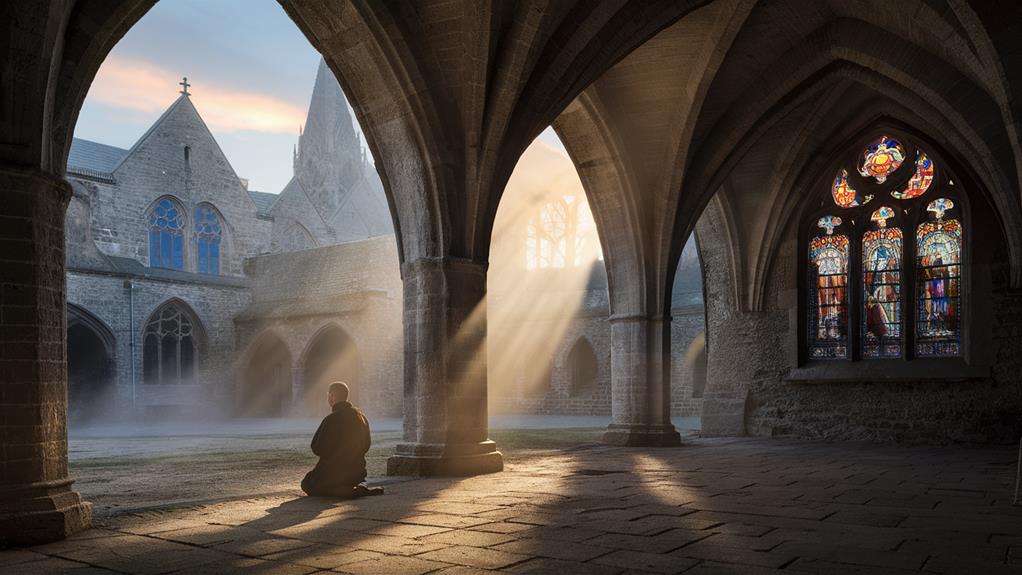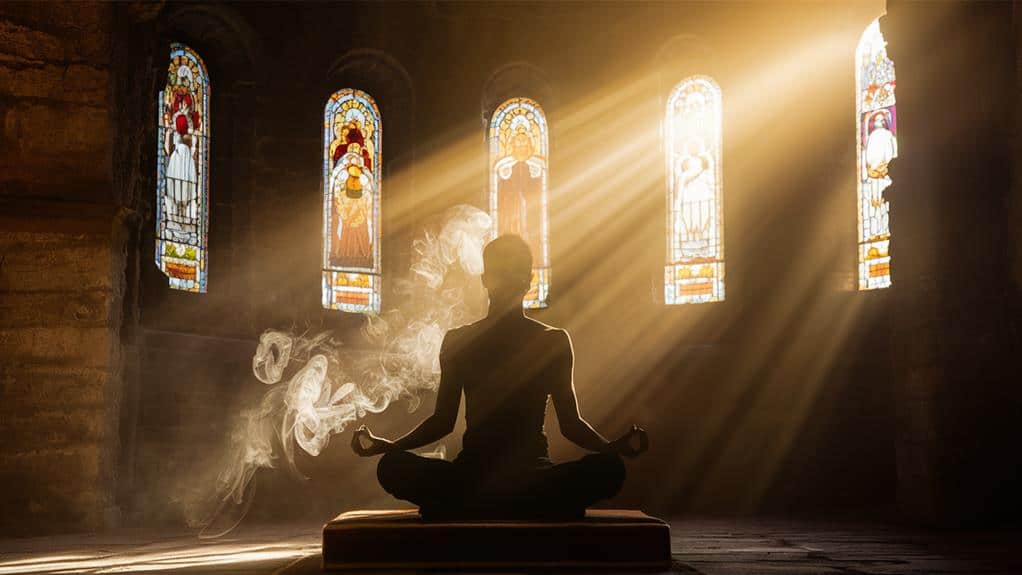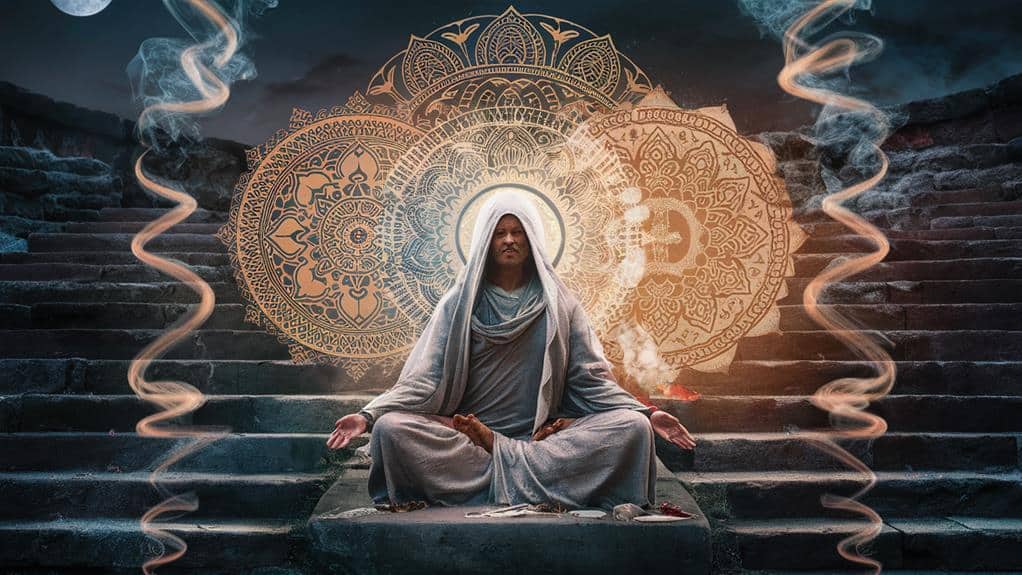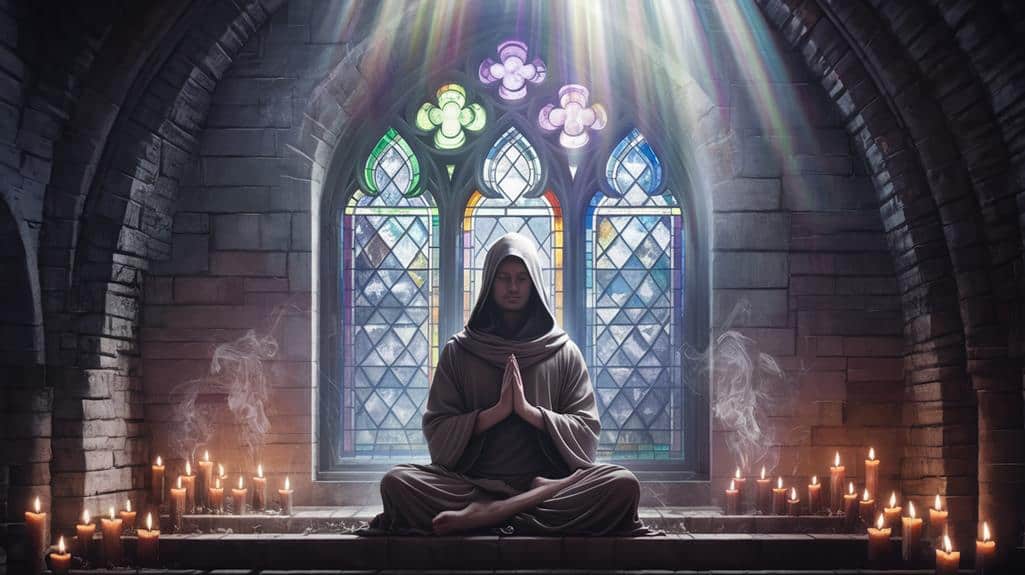Mysticism and the Practice of Contemplative Prayer
You’ll discover that contemplative prayer isn’t just another form of meditation—it’s a profound gateway to mystical experiences that transcend ordinary consciousness. When you enter this sacred practice, you’re following in the footsteps of mystics who’ve charted paths to divine union across centuries and cultures. Through stillness and wordless communion, you’ll encounter dimensions of spirituality that logic alone can’t explain. Whether you’re new to mystical practices or a seasoned practitioner, the ancient art of contemplative prayer offers transformative possibilities that await your exploration in the depths of sacred silence.
Origins of Contemplative Prayer

The origins of contemplative prayer trace back to the earliest days of human spirituality, when ancient mystics sought direct communion with the divine.
You’ll find these practices woven into humanity’s oldest spiritual traditions, from the meditation techniques of Eastern religions to the desert fathers of early Christianity who retreated into silence and solitude.
As you explore deeper, you’ll discover that contemplative prayer emerged independently across various cultures, yet shared remarkable similarities in their approach to inner stillness.
In ancient Egypt, priests would enter states of sacred silence, while Hindu sages developed sophisticated methods of mental quietude.
The Jewish prophets often withdrew to mountaintops and wilderness spaces, seeking divine wisdom through contemplative solitude.
You’re part of this timeless lineage when you engage in contemplative prayer today.
These practices haven’t fundamentally changed – they still center on emptying your mind of daily concerns and opening your heart to transcendent reality.
Whether you’re drawing from Buddhist mindfulness, Christian centering prayer, or Sufi meditation, you’re tapping into methods that have helped seekers find meaning and connection for millennia.
The Mystical Path to Awakening
Four core stages mark the mystical path to awakening: preparation, purification, illumination, and union.
You’ll find that each stage builds upon the previous one, creating a transformative journey that gradually dissolves the barriers between your ordinary consciousness and divine reality. In preparation, you’re learning to quiet your mind through contemplative practices, while purification requires you to face and release your attachments, fears, and limiting beliefs.
As you move into illumination, you’ll experience moments of profound clarity where the veil between the sacred and mundane becomes increasingly transparent.
Your awareness expands beyond personal limitations, and you’ll begin to perceive reality with newfound depth and understanding. In these moments, you’re touching the edges of what mystics call “divine knowing.”
The final stage of union represents complete absorption into the ultimate reality – where you’re no longer separate from the divine presence you seek.
This isn’t merely an intellectual understanding but a lived experience where you transcend the dualistic mind and enter into direct communion with the sacred.
You’ll discover that what you’ve been seeking has always been present, waiting for your recognition.
Silence as Sacred Practice

Sacred silence stands at the heart of contemplative practice, offering you a direct pathway to spiritual awareness. When you enter into deliberate stillness, you’ll discover that silence isn’t merely the absence of sound—it’s a living presence that awakens your deepest intuitions and connects you to the infinite.
Through this sacred quietude, you’re invited to release the constant chatter of your mind and sink into the vast spaciousness of being. As you cultivate silence, you’ll notice how it transforms your inner landscape. You’re no longer bound by the endless stream of thoughts that typically dominate your consciousness.
Instead, you’ll find yourself dwelling in a dimension where wisdom naturally emerges from the depths of your soul. This practice isn’t about forcing yourself into an artificial state of quiet—it’s about allowing yourself to be embraced by the natural silence that’s always present beneath the surface of your daily experience.
Within this sacred container, you’ll discover that silence becomes your greatest teacher, revealing truths that words can never fully express and opening doorways to dimensions of understanding that transcend ordinary perception.
Prayer Beyond Words
Contemplative prayer transcends traditional verbal expressions, inviting you into a wordless communion with the divine. In this sacred space, you’ll discover that silence becomes your language, and stillness your voice. As you release the need for structured prayers and memorized verses, you’ll enter a domain where meaning flows through presence rather than speech.
When you venture beyond words, you’ll find yourself in the depths of what mystics call “pure prayer” – a state where your spirit connects directly with the divine presence. You’re no longer constrained by the limitations of human language; instead, you’re free to experience the ineffable through the quiet knowing of your heart.
This wordless dialogue often manifests as a gentle awareness, a profound peace that surpasses intellectual understanding. You’ll learn to rest in this sacred encounter, where intention replaces articulation, and being supersedes doing.
It’s a practice that transforms your understanding of prayer from a mere activity into a state of receptive presence. Here, in the space beyond words, you’ll discover that the deepest prayers often arise from the quiet center of your being.
Mystical Traditions Across Cultures

While wordless prayer represents a universal gateway to divine connection, mystical traditions throughout history have developed unique pathways to spiritual enlightenment.
You’ll find Sufi mystics whirling in ecstatic dance, Buddhist monks maintaining unwavering focus in zazen meditation, and Christian contemplatives entering the “cloud of unknowing” through centering prayer. Each tradition offers you a distinctive lens through which to glimpse the infinite.
These mystical paths, though culturally diverse, share striking commonalities you can’t ignore.
You’ll discover that whether you’re exploring Hindu yoga, Jewish Kabbalah, or Indigenous shamanic practices, there’s an emphasis on transcending the ego and merging with something greater than yourself.
The methods may differ – some traditions guide you through specific breathing techniques, while others invite you to contemplate sacred texts or natural phenomena – but they’re all pointing toward the same profound truth: direct experience of the divine lies beyond intellectual understanding.
In your own spiritual journey, you might find that these various traditions aren’t contradictory but complementary, each offering unique tools and insights for traversing the depths of contemplative experience.
Preparing the Inner Sanctuary
The journey into mystical prayer begins with creating suitable conditions for inner stillness.
You’ll need to establish both external and internal spaces that support deep contemplation, clearing away the mental clutter that often obscures your spiritual center. Like preparing a temple for sacred ritual, you’re called to mindfully arrange your environment and psyche for divine encounter.
You’ll discover that this preparation isn’t just about finding a quiet room – it’s about cultivating an inner sanctuary that you can access regardless of external circumstances.
Begin by setting boundaries around your practice time, treating it as an inviolable appointment with the sacred. Notice how your body naturally responds to consistent rhythms of silence and stillness, gradually learning to shed the day’s tensions and settle into deeper awareness.
As you develop this inner sanctuary, you’re building a foundation for mystical experience.
Let your breath become an anchor, your posture a gateway, and your intention a flame that illuminates the path inward.
You’re not creating something new but rather uncovering what’s always been present within you.
States of Divine Union

Moving beyond preparation, mystical practitioners encounter distinct states of divine union that transform ordinary awareness into sacred communion. You’ll discover that these states aren’t linear progressions but rather deepening layers of intimacy with the Divine, each revealing new dimensions of spiritual consciousness.
As you enter these domains, you’ll experience what mystics call “infused contemplation,” where you’re no longer the primary actor but instead become receptive to divine initiative.
In these profound states, you’ll find yourself transformed through three primary movements: illumination, where divine light penetrates your understanding; purgation, where attachments fall away like autumn leaves; and unity, where you’ll experience a profound merging with divine presence.
Your ordinary sense of self begins to dissolve, replaced by an expansive awareness that transcends usual mental categories. You’re likely to encounter periods of spiritual ecstasy interwoven with moments of profound stillness, as the boundaries between subject and object, self and Divine, become increasingly transparent.
These states aren’t permanent residences but rather deepening spirals of awareness that gradually reshape your fundamental relationship with reality.
Transformative Power of Stillness
Stillness offers three essential gateways to spiritual transformation: inner silence, sacred pause, and contemplative rest.
When you enter this sacred space of quietude, you’ll discover that stillness isn’t merely the absence of noise but a living presence that nurtures your soul’s deepest longings. Through inner silence, you’ll begin to shed the layers of mental chatter that have obscured your true nature.
As you embrace the sacred pause, you’ll find yourself naturally dropping into a dimension where time seems to dissolve. In these moments, you’re no longer bound by the constraints of your racing thoughts or worldly concerns.
Instead, you’ll experience a profound opening to the divine presence that’s always been within you. The transformative power of stillness reveals itself most fully in contemplative rest, where you’ll discover that true change doesn’t come through effort but through surrender.
Here, in this depths of quiet, you’ll encounter a wisdom that transcends intellectual understanding, as your consciousness expands beyond its usual boundaries. You’ll realize that stillness isn’t just a practice – it’s the very gateway to your spiritual awakening.
Modern Applications of Mystical Prayer

Integrating mystical prayer into modern life requires adapting ancient contemplative practices to contemporary challenges. You’ll find that these timeless methods can transform your daily routines into sacred moments, whether you’re commuting to work, waiting in line, or taking a lunch break.
By incorporating brief periods of centered awareness throughout your day, you’re creating spiritual anchors that help you navigate life’s complexities with greater presence and purpose.
In today’s digitally saturated world, you can establish contemplative spaces within your home or office – quiet corners where you’ll disconnect from screens and reconnect with your inner sanctuary.
These modern applications don’t require monastery walls or mountain retreats; instead, they’re woven into the fabric of your everyday existence. You might practice mindful breathing during virtual meetings, or turn your morning coffee ritual into a moment of sacred pause.
Through these adaptations, you’re bridging ancient wisdom with modern necessity, allowing mystical awareness to infuse your contemporary experience. The key isn’t to escape your world but to transform how you move through it, finding divine presence in each moment’s unfolding.









